
Gaillardia is a genus of flowering plants in the family Asteraceae, native to North and South America. It was named after Maître Gaillard de Charentonneau, an 18th-century French magistrate who was an enthusiastic botanist. The common name may refer to the resemblance of the inflorescence to the brightly patterned blankets made by Native Americans, or to the ability of wild taxa to blanket the ground with colonies. Many cultivars have been bred for ornamental use.

Rudbeckia hirta, commonly called black-eyed Susan, is a North American flowering plant in the family Asteraceae, native to Eastern and Central North America and naturalized in the Western part of the continent as well as in China. It has now been found in all 10 Canadian Provinces and all 48 of the states in the contiguous United States.
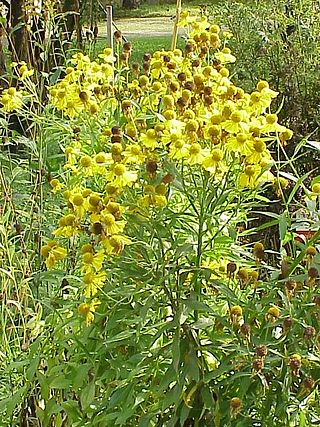
Helenium is a genus of annuals and herbaceous perennial plants in the family Asteraceae, native to the Americas.

Hymenoxys is a genus of plants in the sunflower family, native to North and South America. It was named by Alexandre Henri Gabriel de Cassini in 1828.

Heterotheca, are North American plants in the family Asteraceae.

Helenium autumnale is a North American species of flowering plants in the family Asteraceae. Common names include common sneezeweed and large-flowered sneezeweed.
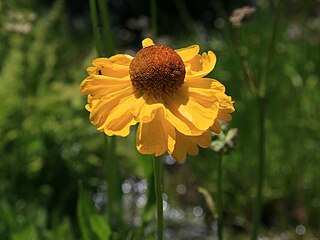
Helenium bigelovii is a North American perennial plant in the sunflower family, commonly known as Bigelow's sneezeweed. It grows in moist areas such as meadows, marshes, or streamsides. It is found at moderate and higher elevations (3000-10,000 ft) in the foothills and mountains of California and Oregon: Cascades, Coast Ranges, Klamath Mountains, Sierra Nevada, etc. Cultivars of the species are used in gardening as ornamentals.

Symphyotrichum laeve is a flowering plant native to Canada, the United States, and Coahuila (Mexico). It has the common names of smooth blue aster, smooth aster, smooth-leaved aster, glaucous Michaelmas-daisy and glaucous aster.
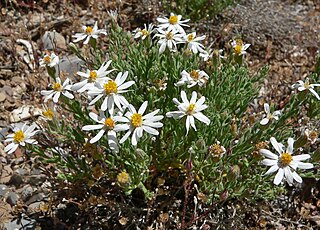
Chaetopappa is a genus of plants in the family Asteraceae which are known generally as leastdaisies.

Erigeron strigosus is a species of flowering plant in the family Asteraceae known by the common names prairie fleabane, common eastern fleabane, and daisy fleabane.

Helenium bolanderi is a North American species of flowering plant in the daisy family known by the common name coastal sneezeweed. It is native to southern Oregon and northern California as far south as Mendocino County, primarily along the seacoast.

Helenium puberulum is a North American species of flowering plants in the daisy family known by the common name rosilla. It is native to California and Baja California, where it can be found in moist habitats such as riverbanks and meadows. It has also been found in Oregon, although these might possibly be naturalized populations.

Helianthus maximiliani is a North American species of sunflower known by the common name Maximilian sunflower.

Hymenoxys odorata is a species of flowering plant in the daisy family known by the common names bitter rubberweed and western bitterweed. It is native to the southwestern and south-central United States from southern California to Texas north as far as Kansas and Colorado, as well as northern Mexico. It grows in dry regions.
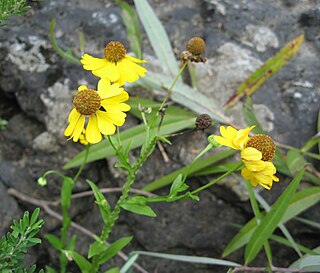
Helenium flexuosum is a North American plant species in the daisy family known by the common name purple sneezeweed. It is widespread across much of eastern and central United States and Canada, from Nova Scotia west to Ontario, Minnesota, and Kansas, south to Florida, Louisiana, and eastern Texas.

Tetraneuris acaulis is a North American species of flowering plants in the sunflower family. Common names include angelita daisy, stemless four-nerve daisy, stemless hymenoxys, butte marigold, and stemless rubberweed.

Machaeranthera asteroides, the fall tansyaster, is a North American species of plants in the sunflower family. It is native to the southwestern United States and northern Mexico.

Helenium drummondii is a species of perennial plant in the Sunflower Family, commonly known as fringed sneezeweed. It is native to the south- central United States, in eastern Texas, Arkansas, and Louisiana.
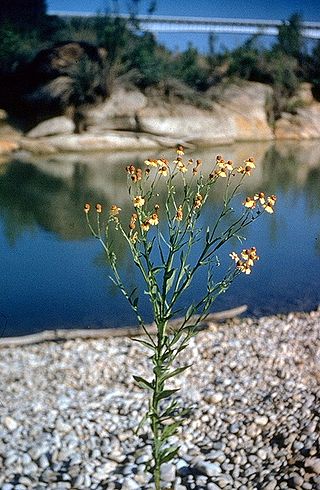
Helenium elegans is a North American perennial plant in the sunflower family, commonly known as pretty sneezeweed. It is native to the south-central United States and to northeastern Mexico.

Helenium microcephalum is a North American perennial plant in the sunflower family, commonly known as smallhead sneezeweed. It is found in the southwestern and south-central United States and northern Mexico.




















